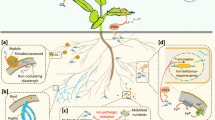Abstract
VA mycorrhizae, the most ancient type of mycorrhizal symbiosis, are present in the most phytogenetically advanced groups. Few plants have evolved mechanisms to completely prevent infection by VAM fungi. Yet, plant species that are less dependent on VA mycorrhizae for nutrient acquisition (e.g., grasses) generally have less root colonization in the field than more dependent species (e.g., Citrus). Among closely related Citrus genotypes, there is a greater tendency for less dependent species to limit the rate but not the extent of colonization, even in high-P soils. We hypothesize that colonization represents a significant carbon cost that may be regulated by the host genotype. Carbon expenditure on the fungus at high P may result in mycorrhizal-induced growth depression. The potential value of breeding plants for greater susceptibility to colonization will depend on the cost/benefit of VA mycorrhizae for the specific crop, soil and environmental conditions. Although the genetics and physiology of host control over VAM colonization are barely known, recently discovered mycorrhizal colonization mutants (myc-) of pea offer great promise for the study of host-fungus compatibility.
Similar content being viewed by others
References
AbbottL K and RobsonA D 1984 The effect of mycorrhizae on plant growth. In VA Mycorrhiza. Eds. C LPowell and D JBagyaraj. pp 113–130. CRC Press, Boca Raton, Florida.
AzconR and OcampoJ A 1981 Factors affecting the vesicular-arbuscular infection and mycorrhizal dependency of thirteen wheat cultivars. New Phytol. 87, 677–685.
BuwaldaJ G and GohG M 1982 Host-fungus competition for carbon as a cause of growth depressions in vesicular-arbuscular ryegrass. Soil Biol. Biochem. 14, 103–106.
CooperK M 1975 Growth responses to the formation of endotrophic mycorrhizas in Solanum leptospernum and New Zealand ferns. In Endomycorrhizas. Eds. F ESanders, BMosse and P BTinker. pp 391–407. Academic Press, London.
CrushJ R 1973 Significance of endomycorrhizas in tussock grassland in Otago, New Zealand. N. Z. J. Bot. 11, 645–660.
CrushJ R 1976 Endomycorrhizas and legume growth in some soils of the Mackenzie Basin, Canterbury, New Zealand. N. Z. J. Agric. Res. 19, 473–476.
CrushJ R and CaradusJ R 1980 Effect of mycorrhizas on growth of some white clovers. N. Z. J. Agric. Res. 23, 233–237.
DucG, TrouvelotA, Gianinazzi-PearsonV and GianinazziS 1989 First report of non-mycorrhizal plant mutants (Myc-) obtained in pea (Pisum sativum) and fababean (Vicia faba L.). Plant Sci. 60, 215–222.
GianinazziS 1991 Vesicular-arbuscular (endo-) mycorrhizas; cellular, biochemical and genetic aspects. Agric. Ecos. Environ. 35, 105–119.
GlennM G, ChewF S and WilliamsP H 1988 Influence of glucosinolate content of Brassica (Cruciferae) roots on growth of vesicular-arbuscular mycorrhizal fungi. New Phytol. 110, 217–225.
GrahamJ H, LeonardR T and MengeJ A 1981 Membrane-mediated decrease in root exudation responsible for phosphorus inhibition of vesicular-arbuscular mycorrhiza formation. Plant Physiol. 68, 548–552.
GrahamJ H, EissenstatD M and DrouillardD L 1991 On the relationship between a plant's mycorrhizal dependency and rate of vesicular-arbuscular mycorrhizal colonization. Functional Ecol. 5, 773–779.
JohnsonN C, CopelandP J, CrookstonR K and PflegerF L 1992 Mycorrhizae: Possible explanation for yield decline with continuous corn and soybean. Agron. J. 84, 387–390.
KrishnaK R, ShettyK G, DartP J and AndrewsD J 1985 Genotype dependent variation in mycorrhizal colonization and response to inoculation of pearl millet. Plant Soil 86, 113–125.
LackieS M, BowleyS R and PetersonR L 1988 Comparison of colonization among half-sib families of Medicago sativa L. by Glomus versiforme (Daniels and Trappe) Berch. New Phytol. 108, 477–482.
ManskeG G B 1989 Genetical analysis of the efficiency of VA mycorrhiza with spring wheat. Agric. Ecos. Environ. 29, 273–280.
MillerD D, DomotoD A and WalkerC 1985 Colonization and efficacy of different endomycorrhizal fungi with apple seedlings at two phosphorus levels. New Phytol. 100, 393–402.
ModjoH S and HendrixJ W 1986 The mycorrhizal fungus, Glomus macrocarpum as a cause of tobacco stunt disease. Phytopathology 76, 668–691.
MosseB 1973 Plant growth responses to vesicular-arbuscular-mycorrhizae. IV. In soil given additional phosphate. New Phytol. 72, 127–136.
Peng S, Eissenstat D M, Graham J H and Williams K 1993 Growth depression in mycorrhizal citrus at high phosphorus supply: Analysis of carbon costs. Plant Physiol. (in press).
SasserM 1990 Identification of bacteria through fatty acid analysis. In Methods in Phytobacteriology. Eds. ZKlement, KRudolf and DSands. pp 199–204. Akademiai Kiado, Budapest.
SchwabS M, MengeJ A and TinkerP B 1991 Regulation of nutrient transfer between host and fungus in vesicular-arbuscular mycorrhizas. New Phytol. 117, 387–398.
SparlingG P and TinkerP B 1978 Mycorrhizal infection in Pennine grassland. I. Levels of infection in the field. J. Appl. Ecol. 15, 943–950.
StribleyD P, TinkerP B and SnellgroveR C 1980 Effect of vesicular-arbuscular mycorrhizal fungi on the relations of plant growth, internal phosphorus concentration and soil phosphate analysis. Soil Sci. 31, 655–672.
TothR, PageT and CastleberryR 1984 Differences in mycorrhizal colonization of maize selections for high and low ear leaf phosphorus. Crop Sci. 24, 994–996.
TothR, TothD, StarkeD and SmithD R 1990 Vesicular-arbuscular colonization in Zea mays affected by breeding for resistance to fungal pathogens. Can. J. Bot. 68, 1039–1044.
TrappeJ M 1987 Phytogenetic and ecologic aspects of mycotrophy in angiosperms from an evolutionary standpoint. In Ecophysiology of VA Mycorrhizal Plants. Ed. G RSafir. pp 5–25, CRC Press, Boca Raton, Florida.
WilliamsK, PercivalF, MerinoJ and MooneyH A 1987 Estimation of tissue construction cost from heat of combustion and organic nitrogen content. Plant Cell Env. 10, 725–734.
Author information
Authors and Affiliations
Additional information
Florida Agricultural Experiment Station Journal Series No. R-02765.
Florida Agricultural Experiment Station Journal Series No. R-02765.
Rights and permissions
About this article
Cite this article
Graham, J.H., Eissenstat, D.M. Host genotype and the formation and function of VA mycorrhizae. Plant Soil 159, 179–185 (1994). https://doi.org/10.1007/BF00000107
Issue Date:
DOI: https://doi.org/10.1007/BF00000107




